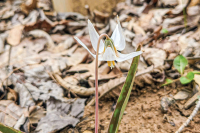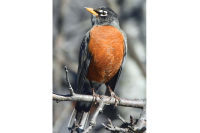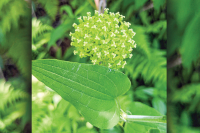The Joyful Botanist: After The Flood
 Adam Bigelow photo
Adam Bigelow photo
Water washes us clean, helps to cook our food and quenches our thirst. Water grows our crops, cools the air and brings the flowers in April and May. Not enough water leads to drought and fire.
Too much water, and there comes the flood. Not enough water, we are dry and parched. Too much water and we drown. This year, after a late summer drought, Western North Carolina has suffered the deluge of flood in the aftermath of Hurricane Helene.
Water determines where plants can grow and how well and healthy they will grow. Just like with humans and other animals, plants can be stressed and damaged by not enough water and by too much water. Just ask any novice home gardener about those impacts. Plants in the wild are no different, and most have adapted to thrive well either in dry or wet locations.
Plants that prefer a rocky, sunny and dry hillsides will wither and wilt if grown in rich, moist garden soil. Plants whose lives are inundated by pond or river water also will suffer if that water dries up or if they are planted in conditions that cause them to dry out. There is, however, a special class of plants that has adapted to and will thrive in conditions that are sometimes too dry or sometimes too wet.
These plants are referred to as riparian plants. Riparian simply means found along a river. These riparian plants will grow well near rivers and creeks, lakes and ponds and are especially tolerant of the ever-changing conditions of these waterways. Sometimes the creeks and rivers are full and raging with stormwater. Often, they are dry and exposed after periods of drought and heat.
Riparian plants are suited to live in these varied conditions. When the soil is dry, their spreading and fibrous roots have the ability to forage for water and nutrients in the soil as needed. During the deluge, these same root masses cling to their perch as they hold onto the soil along the riverbank, helping to keep both plant and soil from washing downstream.
Related Items
Common riparian plants that are found in the Southern Appalachian bioregion include trees, shrubs and herbaceous plants like grasses and wildflowers. Among the riparian trees are the majestic sycamores (Platanus occidentalis) whose peeling bark patterns of white and brown arch out over the river water have seeds that are adapted to float downstream to find a new perch far from their mother tree.
There are many shrubs that are found growing near the water’s edge. These include the medicinally valuable and delicious elderberry (Sambucus canadensis), the beautiful hazel alder (Alnus serrulata) whose golden catkin flowers signal the start of spring and the incredible buttonbush (Cephalanthus occidentalis) who have adapted to growing even in standing water of ponds and eddies.
The proclivity of many plants to grow near or in riparian areas is often found in their common names that include the word swamp. Riparian plants like swamp milkflower (Asclepias incarnata), swamp lousewort (Pedicularis lanceolata), swamp sunflower (Helianthus giganteus) and even the tiny and beautiful swamp jack-in-the-pulpit (Arisaema puisillum) enjoy being swamped with water on occasion.
In considering the inevitable cleanup and restoration of flood-damaged creeks and rivers after the devastating floodwaters recede, these and many other native plants that are adapted to growing along the banks should be strongly considered to be planted and encouraged. Not only are they great at helping stem the inevitable erosion occurring but are beautiful plants that help keep the entire ecosystem in balance, even come hell and high water.
I hope that you are safe and dry while reading this and that your losses in this historic flood were not too great. I am sending out all of my love through the waters that flow amongst the plants and trees. There has been a lot of loss. My heart is now with the recovery, and those impacted the worst.
(The Joyful Botanist leads weekly wildflower walks most Fridays and offers consultations and private group tours through Bigelow’s Botanical Excursions. This email address is being protected from spambots. You need JavaScript enabled to view it..)













